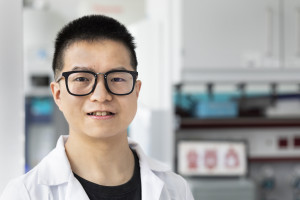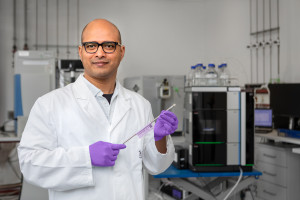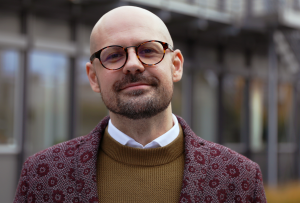Dortmund, 11th January 2022
Suyuan Chen (30) is a chemical biologist specialising in chemical proteomics. After his graduation from the Chengdu Institute of Biology (Chinese Academy of Sciences) in organic chemistry and medicinal chemistry, he began his doctorate at ISAS in 2017. In the interview, the visiting scientist opens up about the characteristics of his work in Dortmund and what he currently longs for.

His unusual career path led doctoral student Suyuan Chen from China to Dortmund – and to application-oriented basic research. At ISAS, he develops chemical tools for analyses.
© ISAS
You’re part of the Proteomics working group. What are you researching now?
Chen: In the Proteomics working group, we’re developing chemical tools for protein post-translational modifications research, biomarker imaging as well as therapeutic targets profiling. The latter refers to disease-causing molecules to which drugs can dock. We also work on identifying off-targets. These are binding sites with which active pharmaceutical ingredients interact, although they are not actually intended for this. The information on off-targets can help avoid side effects and serious consequences for patients early in drug development. For example: I’m currently developing some multi-functional tools for breast cancer diagnosis.
Why did you choose to come to ISAS to obtain your PhD?
Chen: One of the interdisciplinary projects at ISAS, which deals with the mapping of drug binding sites and off-targets, fascinated me! That's why I applied to the Chinese government for a scholarship. Being part of an interdisciplinary project and working with biologists, chemists and bioinformaticians is one of the best aspects of my work at the institute.
What does your typical day at ISAS Campus look like?
Chen: In the morning, I monitor the synthesis of chemical probes in the lab and in the afternoon, I measure biological samples with the mass spectrometer, more precisely with the Orbitrap™. In the evening, I have to analyse the profiling data. Working on such an interdisciplinary project challenges me. You have to function well in the team, have the courage to learn something new at any time and, above all, be open to other points of view. Of course, all of this is a challenge, but it is also lots of fun.
Does the work that you do here differ from your research in China?
Chen: Before coming to the Chinese Academy of Sciences, I studied Pharmaceutical Engineering. Afterwards, I was a medicinal chemist and worked in a joint department of the Chinese Academy of Sciences and a local pharmaceutical company (Chengdu Di'ao Pharmaceutical Group Co. Ltd.). There I mainly focused on clinical needs in China and developed cancer therapies. In Dortmund, I identify targets for cancer therapies. This application-oriented basic research is the scientific preliminary stage of what I used to work on in China. You could say right now, I’m like a salmon swimming against the current, upstream. In my case, that’s basic research. My experience in both areas allows me to see things from a different perspective. This knowledge is very helpful for my work here in Dortmund.
Is there anything particular that you miss about China?
Chen: Hot-Pot and Mianyang Rice Noodle! I was born in a spicy town. I can’t find the taste of my hometown Mianyang anywhere else.
You’re a member of the Chinese-German Chemical Association (CGCA). One of the CGCA’s goals is to promote science communication amongst their members. How important is science communication for you personally?
Chen: Science communication is very important and I can hardly imagine my professional but also private everyday life without it. Because I’m into biomedical research, friends have been asking me for advice since the beginning of the pandemic. The pandemic is unsettling people, and there’s a great demand for scientifically sound answers. But even without the current exceptional situation: science communication can increase public appreciation and understanding of science. As researchers, we should therefore attach importance to a good communication of our work and to the dialogue with the public.
(Cheyenne Peters)








